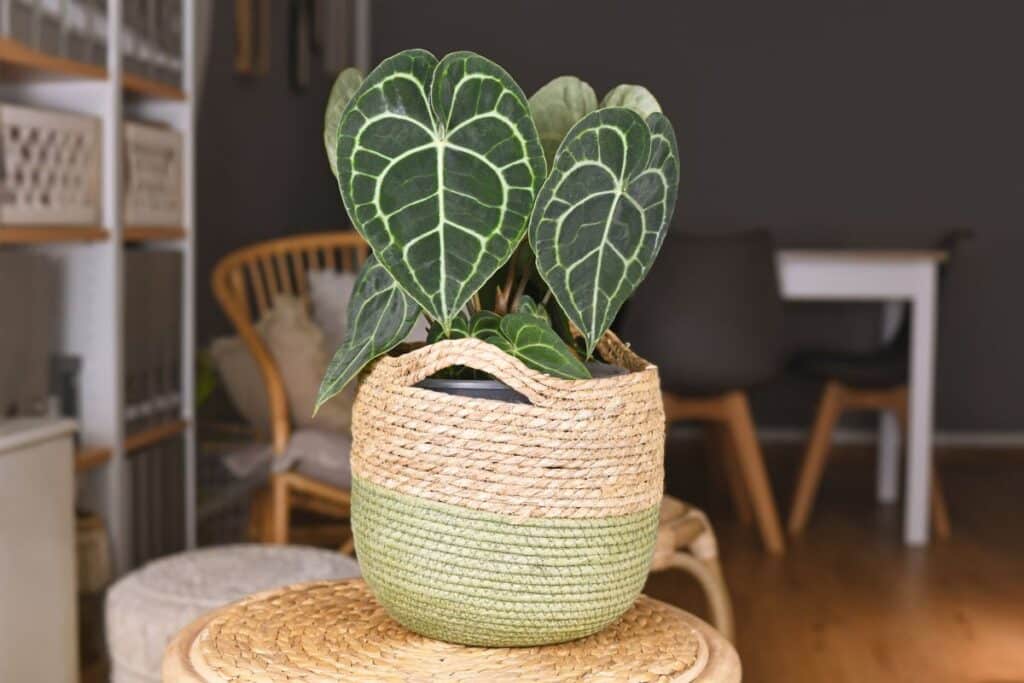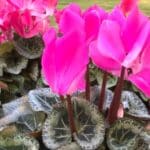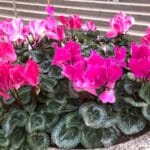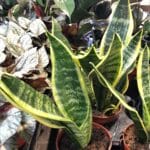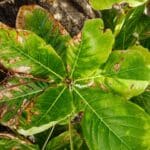The Anthurium clarinervium, also known as the Velvetleaf Anthurium, Velvet Cardboard Anthurium, or Esqueleto, is an epiphyte that is a part of the Aroid family. This plant displays vibrant, velvety, dark green leaves with stark white veins. It truly is a stunning plant.
Like most plants that attach themselves to other natural materials such as trees or cliffsides, they need special attention and care. Because of this, they are primarily a houseplant or reside in greenhouses. They don’t take up much room, but they can take up a lot of your attention.
With the proper watering regime, sunlight, humidity, and temperature, you can help this plant thrive in your home.
Read on to learn how to care for Anthurium plants properly.
Plant Facts
| Scientific name | Anthurium clarinervium |
| Common names | Velvetleaf anthurium, Velvet Cardboard Anthurium, Esqueleto |
| Family | Aroid (plants with a unique spathe and spadix combination) |
| Plant Type | Houseplant |
| Height and Width | Leaves grow anywhere between 6 inches to 12 inches, 2 feet tall, 2-3 feet wide |
| Origin | Chiapas, Mexico |
| Anthurium Clarinervium Flower colors | Lighter green |
| Foliage color | Dark green with white veins |
| Sun Exposure | Bright indirect light or filtered sunlight. |
| Soil Type & pH | Well-draining, chunky potting mix for roots to cling to, 5.5-6.0 pH |
| Special features | Broad, heart-shaped leaves, grows as an epiphyte (plants that cling to other plants for support without harming the host), leathery foliage, flowering but it is largely insignificant, many different varieties with various leaf shapes, hard to find at your local nursery due to high demand. |
How to Grow Anthurium Clarinervium
Before getting into specifics for growing your Velvet Cardboard Anthurium, make sure you purchase a pot with a drainage hole that is slightly bigger than the plant’s root ball. Planting this type of plant in too big of a pot will risk root rot and other diseases.
Additionally, we recommend planting your A. clarinervium in a clear plastic pot so you can view the roots and observe growth. You can grow this plant in a terracotta pot, but the roots might end up sticking to the sides and you’ll have to gently rip them from the sides of the pot.
Finally, if you choose to grow outdoors, you can plant the A. clarinervium when the weather is warm (70-90 degrees Fahrenheit) to optimize growth and reduce the risk of the plant decaying due to colder weather.
Propagation
Propagation of Anthurium clarinervium can be achieved through division or stem cuttings. When dividing the plant, carefully separate the rhizomes or offsets and plant them in individual pots filled with well-draining, aerated potting mix.
Alternatively, stem cuttings can be taken from healthy, mature stems, ensuring each cutting has at least one node.
The best time to propagate this type of plant is during the Springtime when warm temperatures allow the plant to enter its active growing period.
Soil
Appropriate potting soil for Anthurium clarinervium is a well-draining, aerated potting mix that retains moisture while preventing waterlogging. Anthurium clarinervium plants require regular watering to keep their soil evenly moist. However, it is essential to avoid waterlogging, so wait until the surface of the soil has dried before you water again.
A blend of peat moss, perlite, and pine bark or orchid bark provides the ideal balance of water retention and drainage. Additionally, incorporating a small amount of charcoal or coarse sand into the soil mixture can help improve aeration and prevent compaction.
Anthurium clarinervium prefers slightly acidic to neutral soil with a pH range of 6.0 to 7.0. Ensuring the soil is loose and porous allows for optimal root growth and overall health of the plant.
Pruning
Pruning is not a regular care practice for this plant, but it does need maintenance when there are dead or damaged leaves on the stems.
If the leaves are dead, you can gently pull them off with your hands. If the leaves are broken, you might want to utilize a clean, sharp pair of scissors or a knife to remove the leaf from the stem.
It is essential to remove all dead and damaged leaves to prevent diseases from spreading.
Repotting and Transplanting
Repotting and transplanting usually occur every 2-3 years. Just like when you initially planted the Velvetleaf Anthurium, you will need to select a pot that is slightly bigger than the root ball. For specifics, you might want to select a pot that is an inch or two bigger than the root ball.
When you end up planting the Anthurium clarinervium in too big of a pot, you risk the potting mix staying too wet. When this happens, root rot is more likely to occur in addition to yellowing or curling leaves.
When you do repot, hold off from fertilizing for a few weeks to a month so the plant can adjust to its new home.
Anthurium Clarinervium Care Guide
Much like any other epiphyte plant, they are a bit tricky to take care of. Therefore, this plant is not recommended for beginner plant parents.
However, if you have had repeated, long-term success with other houseplants and want to try your hand at cultivating an epiphyte, the A. clarinervium is a great beginner epiphyte. This is so because this type is a little more forgiving with short-term care inconsistencies.
Water
Anthurium clarinervium requires consistent moisture in its soil, but it is susceptible to over watering. Water the plant thoroughly when the top inch of soil feels dry to the touch, allowing excess water to drain away freely.
Avoid letting the soil become waterlogged, as this can lead to root rot and other moisture-related issues. It’s essential to use room temperature water to prevent shocking the plant.
Additionally, providing humidity through methods like regular misting can help maintain moisture levels around the plant’s foliage. Monitoring the soil moisture and adjusting watering frequency accordingly ensures the health and vitality of Anthurium clarinervium.
Sunlight
Anthurium clarinervium prefers mostly bright indirect light, making it well-suited for locations with filtered light or partial shade.
Direct sunlight can scorch its delicate foliage, so it’s best to avoid placing it in south- or west-facing windows where it may receive intense sun exposure.
Indirect light from east-facing or north-facing windows, or placement several feet away from a sunny window with sheer curtains for diffusion, provides the optimal balance of light for Anthurium clarinervium. In areas with low light conditions, supplemental artificial lighting such as fluorescent or LED grow lights can be used to meet its light requirements.
Temperature and Humidity
Anthurium clarinervium thrives in warm temperatures ranging from 65°F to 80°F (18°C to 27°C), making it well-suited for typical indoor environments. It is sensitive to cold drafts and temperatures below 50°F (10°C), which can cause stress and damage to the plant.
Maintaining consistent temperatures and avoiding sudden fluctuations is key to its health and growth. Additionally, Anthurium clarinervium appreciates high humidity levels, ideally between 60% to 80%.
Providing humidity through regular misting, placing the plant on a humidity tray filled with water and pebbles, or using a humidifier can help create the optimal growing conditions for this tropical plant.
Fertilizer
When fertilizing, only fertilize during the active growing season which lands during the Spring and Summer months.
You can dilute an organic fertilizer to half-strength and administer it to your plant every other week.
Pest and diseases
Anthurium clarinervium is a beautiful plant that is susceptible to a few pests and diseases.
The most common pests that can affect Anthurium clarinervium are spider mites, mealybugs, and scale insects. These pests can be controlled by wiping the leaves with a damp cloth or by using an insecticidal soap.
The most common diseases that can affect Anthurium clarinervium are root rot and leaf spot. Leaf spot is a fungal disease that causes brown spots on the leaves, often near the leaf edges. It’s important to keep the plant in a well-draining soil mix and avoid overwatering to prevent root rot
Leaf spot can be treated by removing the affected leaves and keeping the plant in a well-ventilated area.
Regularly inspecting the plant for signs of pests and diseases and taking prompt action can help keep your Anthurium clarinervium healthy and thriving.
Common Varieties and Cultivars
There are several popular varieties of the A. clarinervium to choose from!
- Anthurium Faustomirandae Clarinervium
- A. clarinervium ‘Pterodactyl’
- Anthurium ‘Macrolobium’
The Anthurium Faustomirandae Clarinervium looks very similar to the A. clarinervium variety, but the white veins aren’t as vibrant. In other words, the veins are slightly muted against the dark green leaves.
The “Pterodactyl” variety has more elongated, or narrow, foliage. Instead of having broad, heart-shaped leaves, they are longer and don’t resemble the standard heart shape as closely.
The Anthurium Macrolobium variety is rare and has very dramatic leaves. This variety has one of the largest leaves of all the anthurium family, is lighter green in color, and has slightly muted white veins.
That being said, the A. clarinervium and its varieties are hard to find as they are in high demand. You might want to try other easy-to-find Anthurium types.
FAQs
Is Anthurium clarinervium hard to care for?
Yes, Anthurium clarinervium can be slightly demanding in terms of care, requiring high humidity, indirect light, and well-draining soil. With proper anthurium clarinervium care to these factors, it can thrive indoors.
Do Anthurium clarinervium need a moss pole?
While not essential, a moss pole can provide support for Anthurium clarinervium’s climbing habit and encourage healthy growth. It mimics their natural habitat and can enhance their overall appearance.
Why is my Anthurium clarinervium dying?
Several factors could contribute to an Anthurium clarinervium’s decline, including overwatering, underwatering, inadequate light, pests, or diseases. Assess its environmental conditions and adjust care accordingly to revive it.
What does an overwatered Anthurium look like?
Overwatered Anthurium clarinervium may exhibit symptoms such as yellowing or browning leaves, wilting, mushy stems, or root rot. Additionally, the soil may have a foul odor, indicating anaerobic conditions caused by excessive moisture.
Conclusion
The A. clarinervium is a unique, stunning foliage houseplant native to Mexico. Their epiphyte nature allows them to cling to other plants, trees, cliffsides, and other natural formations without damaging their host.
Because of their natural properties, they are a bit tricky to take care of especially if you are a beginner plant parent. Their watering, soil, temperature, humidity, and sunlight needs are all incredibly specific and need a good green thumb.
With the proper care, you can cultivate a gorgeous, heart-shaped plant for your garden library. Consult your local nursery to find out the right variety for you and start your search for an Anthurium clarinervium today!
*image by firn/depositphotos

